The Cu Chi Tunnels are an underground city built by the Viet Cong during the Vietnam War, stretching 120 km north-west of Saigon. Built between 1940s-1975, it was used as an army base and played a major role in North Vietnam's resistance to American forces. Life in the tunnels was harsh with scarce air, food, and water, but also served as a strategic advantage for the Viet Cong, allowing them to evade US forces until their eventual preservation as a war memorial park.
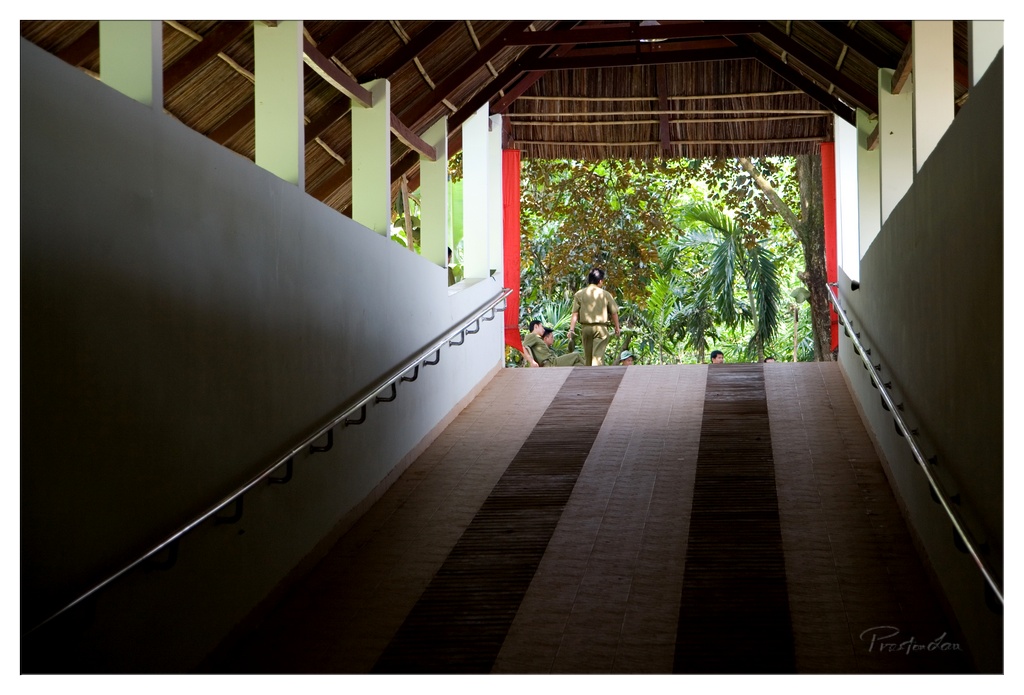

1. Overall Rating (0–10) — 7.0
This photograph captures a quiet moment of transition, where the structure of a covered walkway leads the eye toward a vibrant, sunlit jungle beyond. The contrast between the shadowed interior and the bright natural world outside creates a sense of journey and anticipation. While the composition is strong and the atmosphere evocative, the image’s emotional resonance is slightly muted by a lack of dynamic light and subject engagement.
2. Composition (0–10) — 8.0
The long, linear perspective of the walkway creates a powerful leading line, drawing the viewer’s gaze toward the figures at the far end. The symmetry of the railing and walls enhances balance, while the placement of the figures just off-center adds subtle visual interest without disrupting harmony.
3. Lighting (0–10) — 7.5
The interplay between the deep shadows within the structure and the bright, natural light at the exit creates dramatic contrast. The light spills through the opening, illuminating the foliage and the backs of the figures, enhancing depth and mood. The lighting feels authentic and directional, emphasizing the transition from enclosure to openness.
4. Color & Tone (0–10) — 7.0
The muted earth tones of the walkway—browns, grays, and pale greens—create a subdued palette that complements the natural setting. The vibrant greens and dappled sunlight at the end provide a striking contrast, adding visual energy. The tonal range is well managed, with rich shadows and clear highlights.
5. Creativity (0–10) — 7.5
The image successfully uses architectural elements to frame a narrative of movement and discovery. The juxtaposition of man-made structure and lush nature suggests a story of passage, possibly from confinement to freedom. The photographer’s choice to capture the figures from behind enhances the sense of anonymity and universality.
6. Technical Quality (0–10) — 8.0
The image is sharp and well-focused, particularly along the central axis. The depth of field is controlled, keeping both the foreground and background elements clear. The lighting is well-exposed, with no significant overexposed or underexposed areas, indicating strong technical execution.
7. Emotional Impact (0–10) — 6.5
The photograph evokes a sense of calm introspection and quiet anticipation. The viewer is invited to imagine the journey ahead, both physically and metaphorically. While the emotional pull is subtle, it lingers—especially in the contrast between the still, dark corridor and the promise of life beyond the threshold.
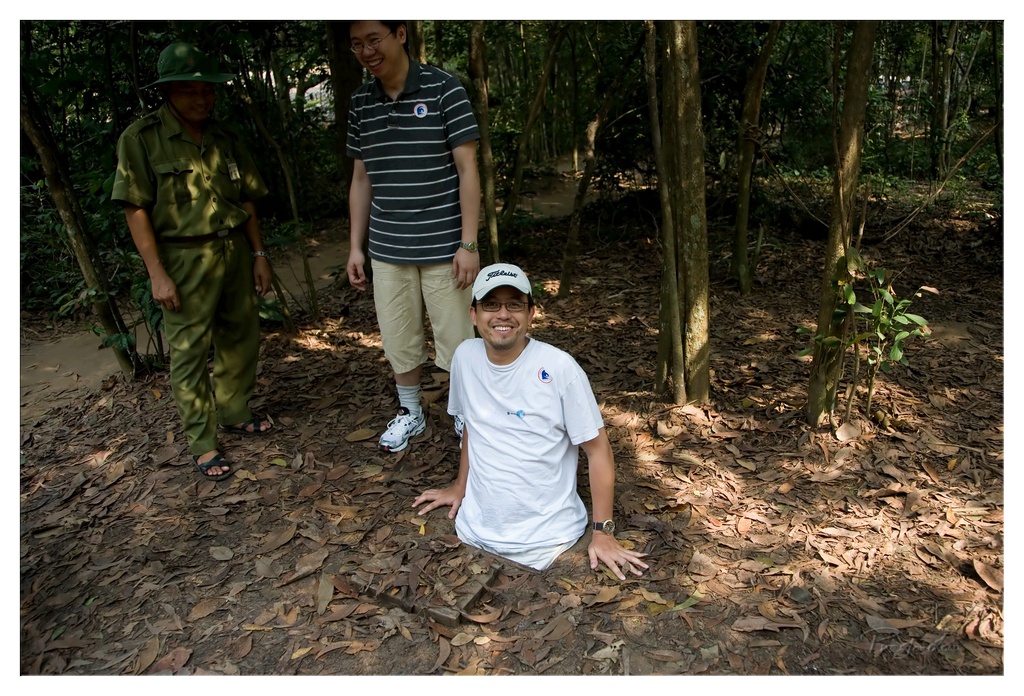

1. Overall Rating (0–10) — 6.0
This photograph captures a candid moment in a forested setting, where three individuals share a quiet, sun-dappled encounter. The natural lighting and earthy tones lend an authentic, documentary feel, while the central figure’s playful pose introduces a sense of lightheartedness. The image succeeds in conveying a moment of connection and curiosity, though its narrative remains slightly obscured by a lack of visual focus and emotional depth.
2. Composition (0–10) — 5.5
The central figure crouched in the foreground draws attention, but the composition feels unbalanced due to the uneven distribution of figures and the cluttered ground. The standing man on the left is partially cut off, creating visual tension, while the depth of field slightly weakens the sense of cohesion.
3. Lighting (0–10) — 6.5
Dappled sunlight filters through the canopy, creating dynamic patterns of light and shadow that enhance the forest atmosphere. While the lighting adds texture and mood, some areas are underexposed, particularly in the background, reducing overall clarity.
4. Color & Tone (0–10) — 6.0
The palette is dominated by earthy greens and browns, with a naturalistic tone that reflects the environment. The colors are subdued, with a slight coolness that tempers the warmth of the sunlight, creating a balanced but not particularly vivid appearance.
5. Creativity (0–10) — 6.5
The photograph captures a genuine, unposed interaction, with a unique perspective that emphasizes the natural setting. The crouched figure’s gesture adds a layer of humor and personality, suggesting a narrative of exploration and shared experience.
6. Technical Quality (0–10) — 7.0
The image is sharp in the foreground, with clean detail in the subjects’ clothing and facial expressions. The exposure is generally well-managed, though some areas of the background lack definition due to shadowing.
7. Emotional Impact (0–10) — 5.5
The scene evokes a sense of adventure and camaraderie, but the emotional resonance is muted by the distance between the viewer and the subjects. The viewer is invited to observe rather than connect, leaving the moment feeling more like a snapshot than a story.
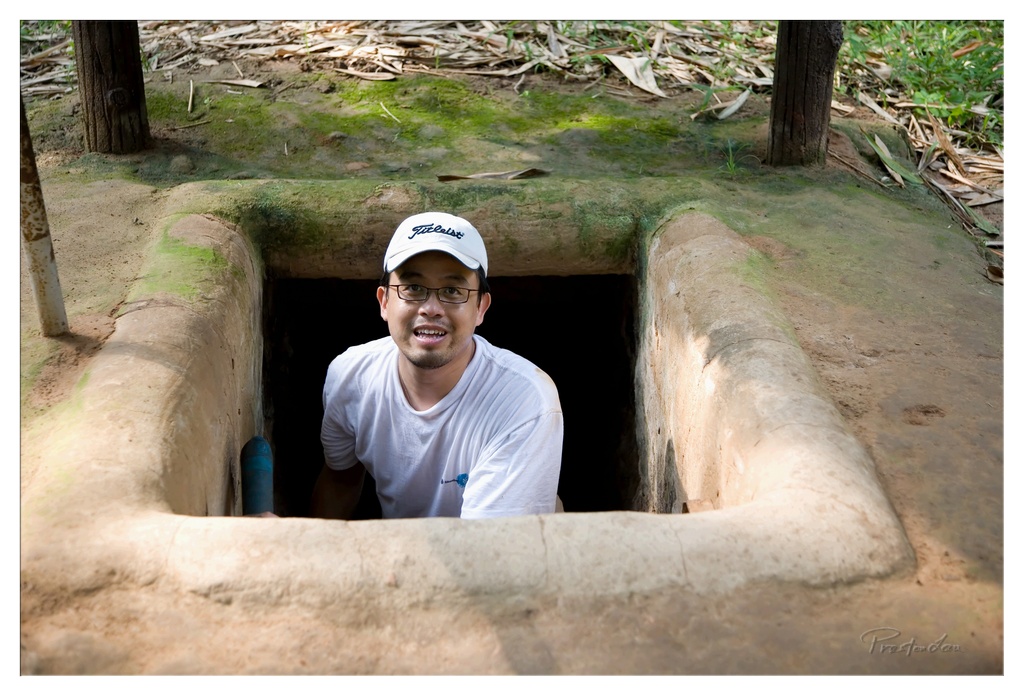

1. Overall Rating (0–10) — 6.0
This photograph captures a moment of quiet discovery, where a man emerges from a rustic underground structure, evoking a sense of curiosity and connection to the earth. The natural setting and the man’s relaxed expression lend an intimate, exploratory mood, though the composition feels slightly candid and unrefined. The image succeeds in telling a small story of human interaction with a man-made environment, but lacks the visual polish to feel fully compelling.
2. Composition (0–10) — 5.5
The subject is centered, but the wide frame and prominent foreground elements create a cluttered feel, drawing attention away from the man’s expression. A tighter crop would enhance focus and intimacy.
3. Lighting (0–10) — 6.0
Natural daylight illuminates the scene evenly, with soft shadows that emphasize texture. The contrast between the bright exterior and the dark interior creates a sense of depth, though the light remains flat and lacks dramatic warmth.
4. Color & Tone (0–10) — 6.5
Earthy tones dominate—browns, greens, and muted grays—creating a cohesive, natural palette. The slight coolness of the light tempers the warmth of the scene, giving it a documentary feel rather than a richly emotive one.
5. Creativity (0–10) — 6.0
The concept of a man emerging from a traditional earthen structure is engaging, suggesting cultural or historical exploration. However, the execution feels more like a snapshot than a deliberate artistic statement.
6. Technical Quality (0–10) — 7.5
The image is sharp and well-focused, with clean detail in the textures of the soil and moss. The exposure is balanced, and the depth of field effectively isolates the subject.
7. Emotional Impact (0–10) — 6.0
The man’s gentle smile and relaxed posture evoke a sense of wonder and contentment, inviting the viewer to imagine the story behind the structure. While not deeply moving, the image conveys a quiet, personal moment of discovery.
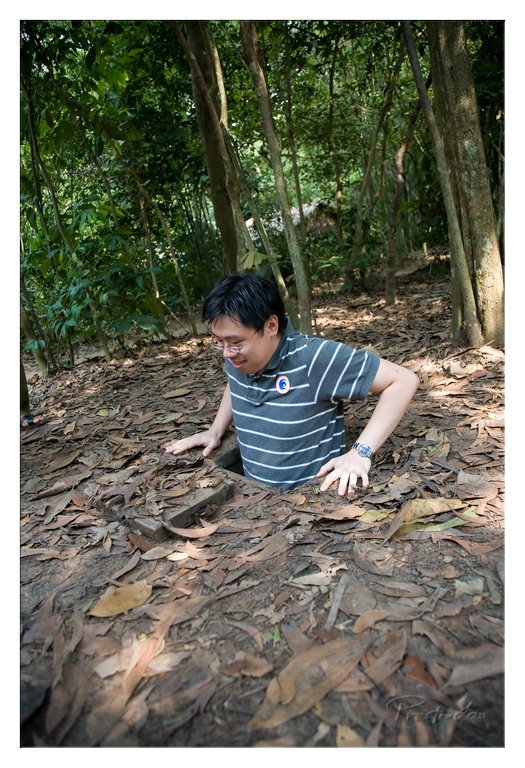

1. Overall Rating (0–10) — 7.0
This photograph captures a moment of playful absurdity, with a man seemingly emerging from a hole in a forest floor, evoking a sense of whimsy and mystery. The natural setting provides a rich backdrop of dappled light and earthy textures, enhancing the surreal quality of the scene. While the image succeeds in creating a memorable narrative, the slightly awkward framing and subdued lighting prevent it from achieving a more polished, cinematic feel.
2. Composition (0–10) — 6.0
The subject is centered but slightly low in the frame, with the hole appearing too small to be convincing, which weakens the visual impact. The surrounding foliage adds depth but also introduces visual clutter.
3. Lighting (0–10) — 6.5
Natural daylight filters through the canopy, creating soft highlights and shadows that enhance the forest atmosphere. However, the lighting is uneven, with some areas underexposed, reducing overall clarity.
4. Color & Tone (0–10) — 6.0
The palette is dominated by earthy browns and greens, creating a naturalistic tone. The colors are somewhat muted, and the lack of vibrancy keeps the image from feeling dynamic.
5. Creativity (0–10) — 7.5
The concept is inventive and humorous, playing with perspective and expectation. The juxtaposition of a man in a striped shirt against a wild forest setting adds a surreal, almost fable-like quality.
6. Technical Quality (0–10) — 7.0
The image is sharp and clear, with good focus on the subject. The depth of field is appropriately managed, though minor distractions in the background slightly detract from the overall clarity.
7. Emotional Impact (0–10) — 6.5
The photograph evokes amusement and curiosity, inviting the viewer to wonder about the story behind the scene. While not deeply moving, it leaves a lasting impression due to its clever and unexpected premise.
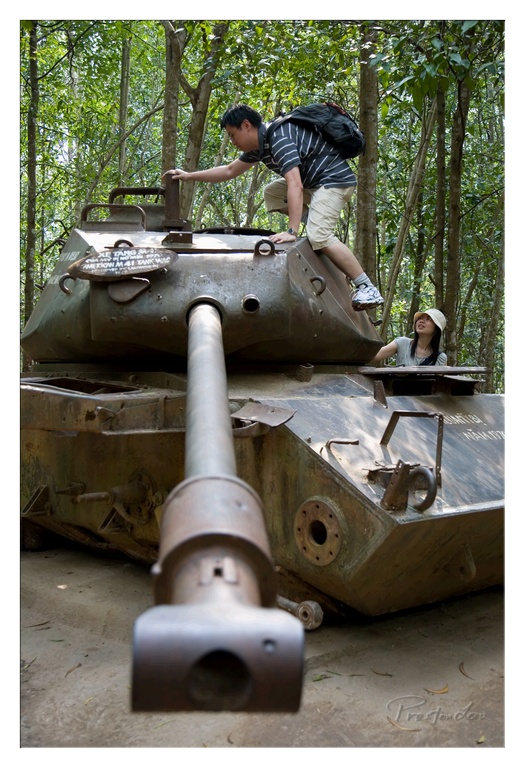

1. Overall Rating (0–10) — 7.0
This photograph captures a striking juxtaposition of war and peace, where a weathered tank in a lush forest becomes a stage for human curiosity and exploration. The low-angle perspective emphasizes the tank’s imposing presence while the climbers introduce a sense of scale and narrative, grounding the image in a moment of human interaction with history. While the composition leans slightly toward the literal, the emotional weight of the scene—where nature reclaims war’s relics and people engage with them—gives the image a quiet power.
2. Composition (0–10) — 7.5
The low-angle shot creates a dramatic sense of scale, with the tank’s cannon leading the eye into the frame. The placement of the climbers adds dynamic energy and narrative depth, though the right side feels slightly unbalanced by the smaller figure. The verticality of the trees contrasts with the horizontal mass of the tank, enhancing visual interest.
3. Lighting (0–10) — 6.5
Natural daylight filters through the canopy, casting soft, dappled light that enhances texture and mood. The lighting is even but not particularly dramatic, with slight overexposure in highlights on the tank’s surface. The shadows add depth but do not fully accentuate the tank’s form.
4. Color & Tone (0–10) — 7.0
The palette is dominated by earthy greens and muted metallic tones, creating a cohesive, naturalistic atmosphere. The green foliage provides a vibrant contrast to the rusted gray of the tank, enhancing the theme of nature reclaiming war. The colors feel authentic, though slightly desaturated, which suits the somber tone.
5. Creativity (0–10) — 7.5
The image succeeds in telling a layered story—of history, memory, and human interaction with the past. The perspective and inclusion of tourists transform a static relic into a living narrative. The choice to frame through the cannon barrel adds a unique, immersive quality that invites the viewer into the scene.
6. Technical Quality (0–10) — 7.5
The image is sharp and well-focused, particularly on the tank’s barrel and the climbers. The depth of field is appropriate, with the foreground and midground clearly rendered. There’s minimal noise, and the overall clarity supports the narrative intent.
7. Emotional Impact (0–10) — 7.0
The photograph evokes a contemplative mood, prompting reflection on conflict, memory, and the passage of time. The presence of people, particularly the woman looking up, adds a human element that makes the scene feel immediate and emotionally resonant, bridging past and present.
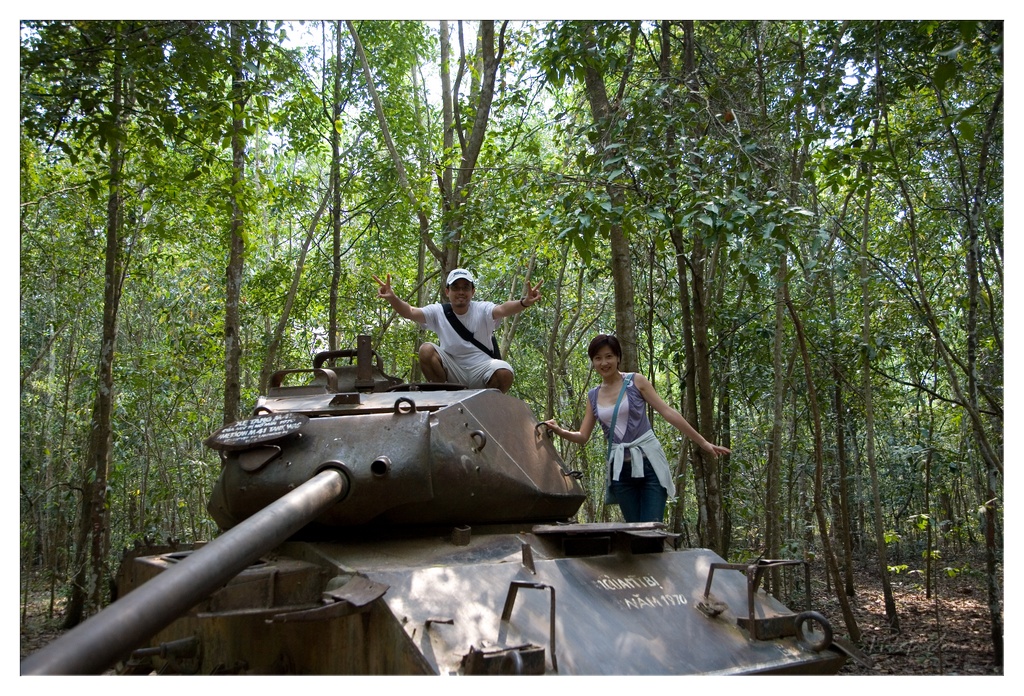

1. Overall Rating (0–10) — 6.0
This photograph captures a moment of lighthearted tourism amidst a historically heavy setting, where two visitors pose with a weathered tank in a dense forest. The juxtaposition of casual gestures and solemn surroundings creates a subtle tension—partly humorous, partly reflective. While the image succeeds in documenting a travel experience, it lacks the emotional weight or visual discipline to transcend a simple snapshot, feeling more like a memory than a statement.
2. Composition (0–10) — 6.0
The tank anchors the lower half of the frame, providing a strong diagonal line, but the subjects are slightly off-center and the forest background feels cluttered. A tighter crop would better focus attention on the interaction between people and object.
3. Lighting (0–10) — 6.5
Natural daylight filters through the canopy, creating soft, dappled light that adds texture and depth. However, the uneven exposure in the highlights and shadows slightly diminishes detail in both the foliage and the tank’s surface.
4. Color & Tone (0–10) — 6.0
The palette is dominated by green and muted metallic gray, creating a natural, earthy tone. While cohesive, the colors lack vibrancy, giving the image a slightly flat and unpolished appearance.
5. Creativity (0–10) — 5.5
The concept of pairing tourists with a war relic in a jungle setting is inherently layered, but the execution feels conventional. The image captures a common tourist moment without offering a fresh or deeply resonant perspective.
6. Technical Quality (0–10) — 7.0
The focus is sharp on the tank and subjects, and the exposure is generally balanced. The slight softness in the background and minor noise in the shadows are minor technical drawbacks.
7. Emotional Impact (0–10) — 5.0
The emotional resonance is muted—while the setting suggests historical gravity, the subjects’ cheerful expressions create a dissonance that keeps the viewer from fully engaging with the deeper context.
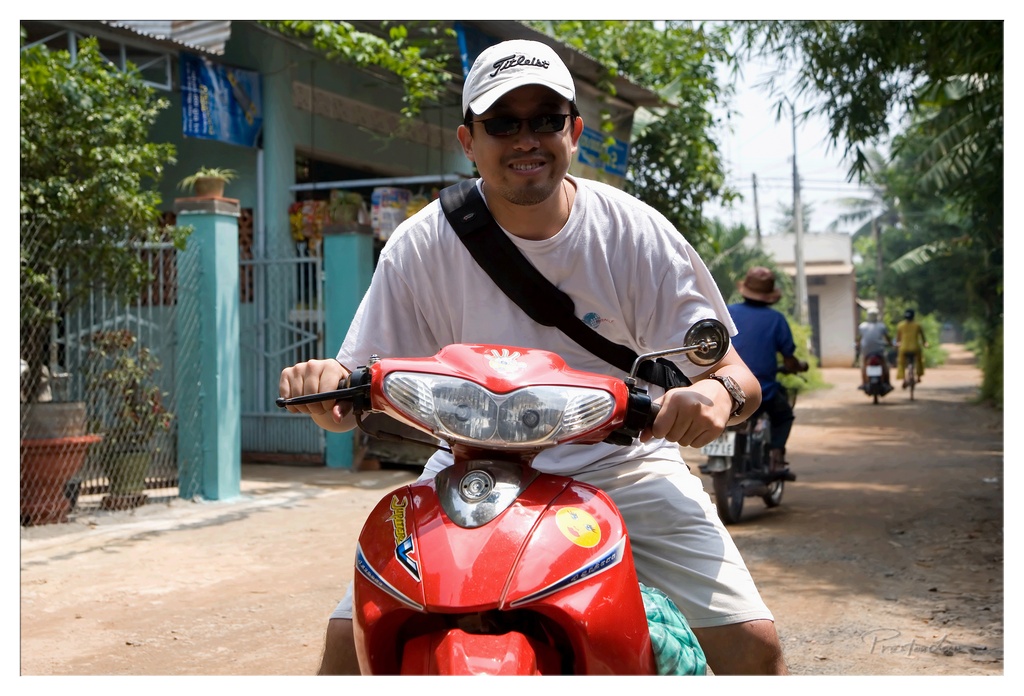

1. Overall Rating (0–10) — 7.0
This photograph captures a candid moment of travel and connection, with the subject’s warm smile and relaxed posture conveying a sense of joy and ease. The vibrant red scooter draws the eye and contrasts beautifully with the soft, natural light of the tropical setting, while the background activity adds authenticity and depth. Though the composition leans slightly casual, it succeeds in telling a story of movement and cultural immersion—its charm lies in its unpolished honesty.
2. Composition (0–10) — 6.5
The subject is well-centered and engaging, with the scooter creating a strong diagonal leading into the frame. The background activity provides context but slightly distracts from the focal point, and the depth of field could be tighter to emphasize the man more.
3. Lighting (0–10) — 7.0
Natural daylight bathes the scene in soft, even light, highlighting the subject’s features and the scooter’s glossy surface. The shadows are subtle, and the bright sky is slightly overexposed, but overall the lighting enhances the warm, open-air atmosphere.
4. Color & Tone (0–10) — 7.5
The rich red of the scooter stands out against the muted greens and earth tones, creating a visually dynamic contrast. The overall color palette feels natural and balanced, with a slight warmth that complements the tropical setting.
5. Creativity (0–10) — 7.0
The image captures a moment of personal connection with place and transport, blending portraiture with travel photography. While the scene is familiar, the composition and subject’s expression give it a unique, narrative quality.
6. Technical Quality (0–10) — 7.5
The focus is sharp on the man and scooter, with good clarity throughout. The image is well-exposed, though the background shows some loss of detail due to bright lighting and slight overexposure.
7. Emotional Impact (0–10) — 7.5
There’s an immediate sense of happiness and adventure, with the subject’s genuine smile creating a strong emotional connection. The viewer is invited into a moment of personal discovery, evoking a sense of wanderlust and warmth.
Loading map...